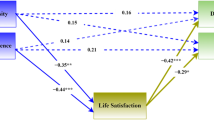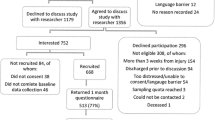Abstract
Objectives
This study describes the prevalence of pain in trauma patients 1 year after hospital admission and investigates separately health-related quality of life (QoL) for patients suffering severe pain and for those without pain. Moreover, psychosocial factors are examined for their impact on pain.
Methods
Patients were contacted 12 months after admission in order to complete the following questionnaires: Medical Outcomes Study 36-Item Short Form Health Survey (SF-36), Trauma Outcome Profile (TOP), Beck Depression Inventory (BDI), State-Trait Anxiety Inventory (STAI), Impact of Event Scale—Revised (IES-R) and additional questions concerning satisfaction, work and financial status. Relevant pain at follow-up was defined as <80 points on the pain subscale of the TOP.
Results
Two hundred and twenty patients were included. The Injury Severity Score (ISS) ranged from 1 to 41. Fifty-three percent (53 %) of patients suffered a severe trauma (ISS > 15). One year after injury, 55 % of patients had relevant pain according to the TOP. Patients with pain were older (41.4 vs. 34.4 years, p = 0.003) and had slightly more severe injuries (ISS 17.1 vs. 14.9, p = 0.115). There were significant differences between pain and no-pain patients on all domains of QoL (p < 0.001) and on the BDI, STAI and IES-R (p < 0.001). Pain patients more often experienced a stressful event and job-related and financial difficulties. Multivariate logistic regression analysis revealed post-traumatic stress disorder (PTSD) as the strongest predictor for pain [odds ratio (OR): 4.38, p = 0.015], followed by a stressful life event (OR: 4.08, p = 0.001).
Discussion
Pain is strongly associated with psychosocial complaints 1 year after trauma. For the treatment of pain following a traumatic event, social reintegration and emotional regulation by means of occupational rehabilitation and psychotherapy should receive more attention.



Similar content being viewed by others
References
Holbrook TL, Anderson JP, Sieber WJ, Browner D, Hoyt DB. Outcome after major trauma: discharge and 6-month follow-up results from the Trauma Recovery Project. J Trauma. 1998;45(2):315–24.
Blanchard EB, Hickling EJ, Taylor AE, Loos W. Psychiatric morbidity associated with motor vehicle accidents. J Nerv Ment Dis. 1995;183(8):495–504.
van der Sluis CK, Eisma WH, Groothoff JW, ten Duis HJ. Long-term physical, psychological and social consequences of severe injuries. Injury. 1998;29(4):281–5.
Mayou R, Bryant B. Outcome 3 years after a road traffic accident. Psychol Med. 2002;32(4):671–5.
Mayou R, Tyndel S, Bryant B. Long-term outcome of motor vehicle accident injury. Psychosom Med. 1997;59(6):578–84.
Mayou R, Simkin S, Threlfall J. The effects of road traffic accidents on driving behaviour. Injury. 1991;22(5):365–8.
Bullinger M. Assessing health related quality of life in medicine. An overview over concepts, methods and applications in international research. Restor Neurol Neurosci. 2002;20(3–4):93–101.
Neugebauer E, Lefering R, Bouillon B, Bullinger M, Wood-Dauphinee S. Quality of life after multiple trauma. Aim and scope of the conference. Restor Neurol Neurosci. 2002;20(3–4):87–92.
Ringdal M, Plos K, Lundberg D, Johansson L, Bergbom I. Outcome after injury: memories, health-related quality of life, anxiety, and symptoms of depression after intensive care. J Trauma. 2009;66(4):1226–33.
Sluys K, Häggmark T, Iselius L. Outcome and quality of life 5 years after major trauma. J Trauma. 2005;59(1):223–32.
Lee BO, Chaboyer W, Wallis M. Predictors of health-related quality of life 3 months after traumatic injury. J Nurs Scholarsh. 2008;40(1):83–90.
Timmers TK, Verhofstad MH, Moons KG, van Beeck EF, Leenen LP. Long-term quality of life after surgical intensive care admission. Arch Surg. 2011;146(4):412–8.
Liu M, Ferrante FM. Overview of pain mechanisms and neuroanatomy. In: Rosenberg AD, Grande CM, Bernstein RL, editors. Pain management and regional anesthesia in trauma. London: WB Saunders; 2000. p. 29–46.
Berben SA, Meijs TH, van Dongen RT, van Vugt AB, Vloet LC, Mintjes-de Groot JJ, et al. Pain prevalence and pain relief in trauma patients in the Accident & Emergency department. Injury. 2008;39(5):578–85.
Rivara FP, Mackenzie EJ, Jurkovich GJ, Nathens AB, Wang J, Scharfstein DO. Prevalence of pain in patients 1 year after major trauma. Arch Surg. 2008;143(3):282–7; discussion 288.
Mkandawire NC, Boot DA, Braithwaite IJ, Patterson M. Musculoskeletal recovery 5 years after severe injury: long term problems are common. Injury. 2002;33(2):111–5.
Castillo RC, MacKenzie EJ, Wegener ST, Bosse MJ. Prevalence of chronic pain seven years following limb threatening lower extremity trauma. Pain. 2006;124(3):321–9.
Williamson OD, Epi GD, Gabbe BJ, Physio B, Cameron PA, Edwards ER, et al. Predictors of moderate or severe pain 6 months after orthopaedic injury: a prospective cohort study. J Orthop Trauma. 2009;23(2):139–44.
Von Korff M, Crane P, Lane M, Miglioretti DL, Simon G, Saunders K, et al. Chronic spinal pain and physical-mental comorbidity in the United States: results from the national comorbidity survey replication. Pain. 2005;113(3):331–9.
Arnow BA, Hunkeler EM, Blasey CM, Lee J, Constantino MJ, Fireman B, et al. Comorbid depression, chronic pain, and disability in primary care. Psychosom Med. 2006;68(2):262–8.
Michaels AJ, Michaels CE, Smith JS, Moon CH, Peterson C, Long WB. Outcome from injury: general health, work status, and satisfaction 12 months after trauma. J Trauma. 2000;48(5):841–8; discussion 848–50).
Meerding WJ, Looman CW, Essink-Bot ML, Toet H, Mulder S, van Beeck EF. Distribution and determinants of health and work status in a comprehensive population of injury patients. J Trauma. 2004;56(1):150–61.
Ponsford J, Hill B, Karamitsios M, Bahar-Fuchs A. Factors influencing outcome after orthopedic trauma. J Trauma. 2008;64(4):1001–9.
Tøien K, Bredal IS, Skogstad L, Myhren H, Ekeberg O. Health related quality of life in trauma patients. Data from a one-year follow up study compared with the general population. Scand J Trauma Resusc Emerg Med. 2011;19:22.
McClure RJ, Douglas RM. The public health impact of minor injury. Accid Anal Prev. 1996;28(4):443–51.
Au EH, Holdgate A. Characteristics and outcomes of patients discharged home from the Emergency Department following trauma team activation. Injury. 2010;41(5):465–9.
Merskey H, Bogduk N. Classification of chronic pain: descriptions of chronic pain syndromes and definitions of pain terms. Seattle: IASP Press; 1994.
Bullinger M, Kirchberger I. Der SF-36 Fragebogen zum Gesundheitszustand: Handanweisung. Goettingen: Hogrefe-Verlag; 1998.
Ellert U, Bellach BM. The SF-36 in the Federal Health Survey—description of a current normal sample. Gesundheitswesen. 1999;61 Spec No:S184–90.
Pirente N, Ottlik Y, Lefering R, Bouillon B, Neugebauer E. Quality of life in multiply injured patients: development of the Trauma Outcome Profile (TOP) as part of the modular Polytrauma Outcome (POLO) chart. Eur J Trauma. 2006;32:44–62.
Pirente N, Bouillon B, Schäfer B, Raum M, Helling H-J, Berger E, et al. Systematische Entwicklung eines Messinstruments zur Erfassung der gesundheitsbezogenen Lebensqualität beim polytraumatisierten Patienten—die Polytrauma-Outcome- (POLO-)Chart. Unfallchirurg. 2002;105(5):413–22.
Lefering R, Tecic T, Schmidt Y, Pirente N, Bouillon B, Neugebauer E. Quality of life after multiple trauma: validation and population norm of the Polytrauma Outcome (POLO) chart. Eur J Trauma Emerg Surg. 2012;38:403–15.
Hautzinger M, Bailer M, Worall H, Keller F. Beck-Depressions-Inventar (BDI). Bern: Verlag Hans Huber; 1994.
Laux L, Glanzmann P, Schaffner P, Spielberger CD. Das State-Trait-Angstinventar (STAI). Göttingen: Testzentrale; 1981.
Maercker A, Schützwohl M. Erfassung von psychischen Belastungsfolgen: die Impact of Event Skala-revidierte Version (IES-R). Diagnostica. 1998;44:130–41.
Baker SP, O’Neill B, Haddon W Jr, Long WB. The injury severity score: a method for describing patients with multiple injuries and evaluating emergency care. J Trauma. 1974;14:187–96.
Gagliese L. Pain and aging: the emergence of a new subfield of pain research. J Pain. 2009;10(4):343–53.
Rittger H, Rieber J, Breithardt OA, Dücker M, Schmidt M, Abbara S, et al. Influence of age on pain perception in acute myocardial ischemia: a possible cause for delayed treatment in elderly patients. Int J Cardiol. 2011;149(1):63–7. doi:10.1016/j.ijcard.2009.11.046.
Soltow D, Given BA, Given CW. Relationship between age and symptoms of pain and fatigue in adults undergoing treatment for cancer. Cancer Nurs. 2010;33(4):296–303.
Gibson SJ, Farrell M. A review of age differences in the neurophysiology of nociception and the perceptual experience of pain. Clin J Pain. 2004;20(4):227–39.
Cassel CK. Geriatric medicine: an evidence-based approach. New York: Springer; 2003.
Ulvik A, Kvåle R, Wentzel-Larsen T, Flaatten H. Quality of life 2–7 years after major trauma. Acta Anaesthesiol Scand. 2008;52(2):195–201.
Harris IA, Young JM, Rae H, Jalaludin BB, Solomon MJ. Predictors of post-traumatic stress disorder following major trauma. ANZ J Surg. 2008;78(7):583–7.
Epping-Jordan JE, Wahlgren DR, Williams RA, Pruitt SD, Slater MA, Patterson TL, et al. Transition to chronic pain in men with low back pain: predictive relationships among pain intensity, disability, and depressive symptoms. Health Psychol. 1998;17(5):421–7.
Eisenberger NI, Lieberman MD, Williams KD. Does rejection hurt? An FMRI study of social exclusion. Science. 2003;302(5643):290–2.
Panksepp J. Neuroscience. Feeling the pain of social loss. Science. 2003;302(5643):237–9.
Sharp TJ, Harvey AG. Chronic pain and posttraumatic stress disorder: mutual maintenance? Clin Psychol Rev. 2001;21(6):857–77.
Asmundson GJ, Katz J. Understanding the co-occurrence of anxiety disorders and chronic pain: state-of-the-art. Depress Anxiety. 2009;26(10):888–901.
McLean SA, Clauw DJ, Abelson JL, Liberzon I. The development of persistent pain and psychological morbidity after motor vehicle collision: integrating the potential role of stress response systems into a biopsychosocial model. Psychosom Med. 2005;67(5):783–90.
Siddall PJ, Cousins MJ. Persistent pain as a disease entity: implications for clinical management. Anesth Analg. 2004;99(2):510–20.
Young Casey C, Greenberg MA, Nicassio PM, Harpin RE, Hubbard D. Transition from acute to chronic pain and disability: a model including cognitive, affective, and trauma factors. Pain. 2008;134(1–2):69–79.
Carty J, O’Donnell M, Evans L, Kazantzis N, Creamer M. Predicting posttraumatic stress disorder symptoms and pain intensity following severe injury: the role of catastrophizing. Eur J Psychotraumatol. 2011;2:5652.
Turner JA, Aaron LA. Pain-related catastrophizing: what is it? Clin J Pain. 2001;17(1):65–71.
McWilliams LA, Holmberg D. Adult attachment and pain catastrophizing for self and significant other. Pain. 2010;149(2):278–83.
Kratz AL, Davis MC, Zautra AJ. Attachment predicts daily catastrophizing and social coping in women with pain. Health Psychol. 2012;31(3):278–85.
Hodgkins P, Montejano L, Sasané R, Huse D. Risk of injury associated with attention-deficit/hyperactivity disorder in adults enrolled in employer-sponsored health plans: a retrospective analysis. Prim Care Companion CNS Disord. 2011;13(2). pii: PCC.10m01031. doi:10.4088/PCC.10m01031.
Lam LT. Attention Deficit Disorder and hospitalization due to injury among older adolescents in New South Wales, Australia. J Atten Disord. 2002;6(2):77–82.
Janssen C, Ommen O, Neugebauer E, Lefering R, Pfaff H. Predicting health-related quality of life of severely injured patients: sociodemographic, economic, trauma, and hospital stay-related determinants. Eur J Trauma Emerg Surg. 2008;34:277–86.
Michaels AJ, Michaels CE, Moon CH, Zimmerman MA, Peterson C, Rodriguez JL. Psychosocial factors limit outcomes after trauma. J Trauma. 1998;44(4):644–8.
Acknowledgements
Supported by the German Research Foundation (DFG), grant numbers NE 385/6-3 and 6-4.
Conflict of interest
All of the authors declare that there is no conflict of interest.
Author information
Authors and Affiliations
Corresponding author
Rights and permissions
About this article
Cite this article
Tecic, T., Lefering, R., Althaus, A. et al. Pain and quality of life 1 year after admission to the emergency department: factors associated with pain. Eur J Trauma Emerg Surg 39, 353–361 (2013). https://doi.org/10.1007/s00068-013-0271-9
Received:
Accepted:
Published:
Issue Date:
DOI: https://doi.org/10.1007/s00068-013-0271-9




